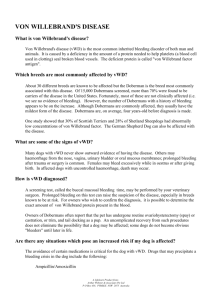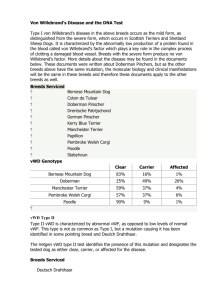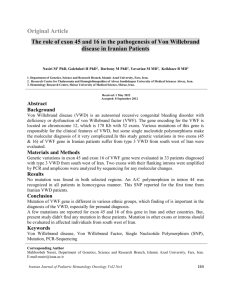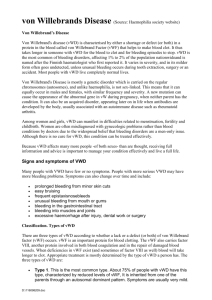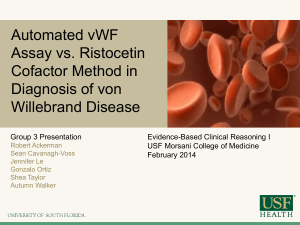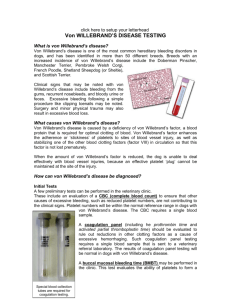von WILLEBRAND`s DISEASE
advertisement
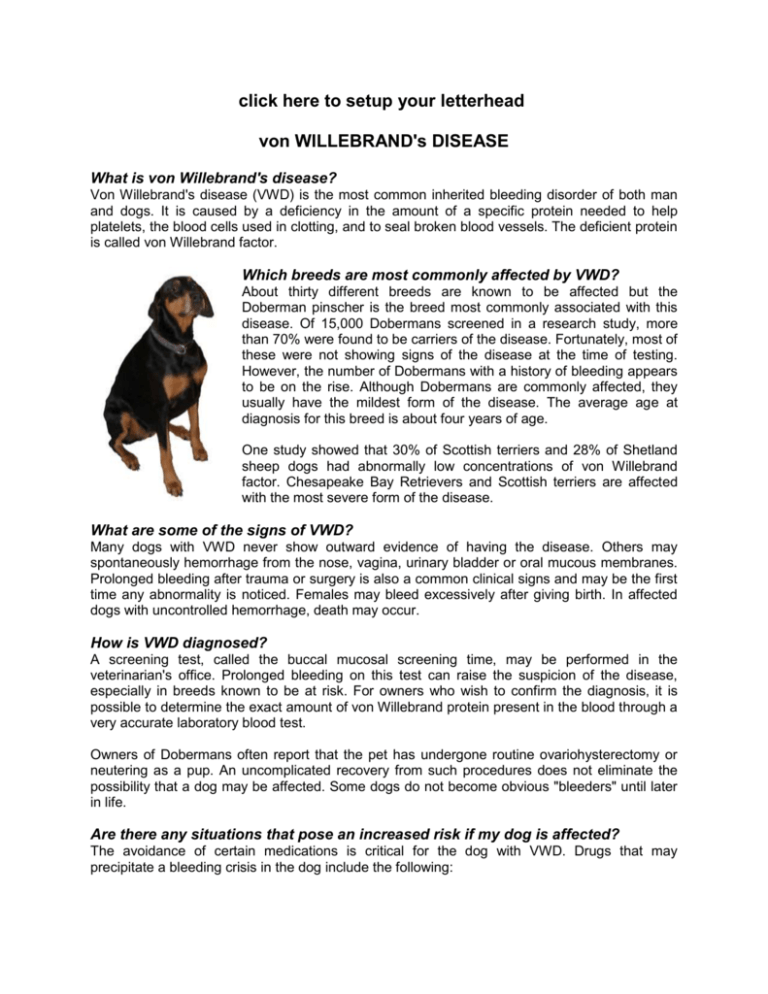
click here to setup your letterhead von WILLEBRAND's DISEASE What is von Willebrand's disease? Von Willebrand's disease (VWD) is the most common inherited bleeding disorder of both man and dogs. It is caused by a deficiency in the amount of a specific protein needed to help platelets, the blood cells used in clotting, and to seal broken blood vessels. The deficient protein is called von Willebrand factor. Which breeds are most commonly affected by VWD? About thirty different breeds are known to be affected but the Doberman pinscher is the breed most commonly associated with this disease. Of 15,000 Dobermans screened in a research study, more than 70% were found to be carriers of the disease. Fortunately, most of these were not showing signs of the disease at the time of testing. However, the number of Dobermans with a history of bleeding appears to be on the rise. Although Dobermans are commonly affected, they usually have the mildest form of the disease. The average age at diagnosis for this breed is about four years of age. One study showed that 30% of Scottish terriers and 28% of Shetland sheep dogs had abnormally low concentrations of von Willebrand factor. Chesapeake Bay Retrievers and Scottish terriers are affected with the most severe form of the disease. What are some of the signs of VWD? Many dogs with VWD never show outward evidence of having the disease. Others may spontaneously hemorrhage from the nose, vagina, urinary bladder or oral mucous membranes. Prolonged bleeding after trauma or surgery is also a common clinical signs and may be the first time any abnormality is noticed. Females may bleed excessively after giving birth. In affected dogs with uncontrolled hemorrhage, death may occur. How is VWD diagnosed? A screening test, called the buccal mucosal screening time, may be performed in the veterinarian's office. Prolonged bleeding on this test can raise the suspicion of the disease, especially in breeds known to be at risk. For owners who wish to confirm the diagnosis, it is possible to determine the exact amount of von Willebrand protein present in the blood through a very accurate laboratory blood test. Owners of Dobermans often report that the pet has undergone routine ovariohysterectomy or neutering as a pup. An uncomplicated recovery from such procedures does not eliminate the possibility that a dog may be affected. Some dogs do not become obvious "bleeders" until later in life. Are there any situations that pose an increased risk if my dog is affected? The avoidance of certain medications is critical for the dog with VWD. Drugs that may precipitate a bleeding crisis in the dog include the following: Aspirin Phenylbutazone Ibuprofen Ampicillin/Amoxicillin Phenothiazine tranquilizers Theophylline Antihistamines Sulfa-based antibiotics Estrogens Penicillin Heparin Emotional stress is thought to precipitate bleeding in humans with the disease. The subjective nature of such a finding makes it difficult to know if there may be a similar association in dogs, although this remains a possibility. What can be done to treat dogs with VWD? In an emergency situation, transfusion of blood or fresh frozen plasma may stabilize the patient. The dog donating blood may be treated with a drug called DDAVP prior to blood collection. DDAVP will raise the level of von Willebrand factor in the donor's blood, an obvious benefit for the dog with VWD. Some dogs with VWD are able to increase the amount of protein in circulation after the administration of DDAVP, although the response is variable. At this time, it is not recommended to use this drug on a regular basis. The drug is expensive, and not all dogs will respond to it. The drugs listed above should be avoided when possible, but especially when the dog is in a bleeding crisis. If I own a Doberman that has always been healthy, should I do something? Since many affected Dobermans will never have bleeding problems, any recommendation to do routine testing is debatable. However, identification of dogs that have abnormal bleeding times can be very valuable if surgery is planned. Additionally, knowing that your dog is a carrier of VWD can be very important if an injury occurs. This client information sheet is based on material written by Ernest Ward, DVM. © Copyright 2005 Lifelearn Inc. Used with permission under license. February 5, 2016
